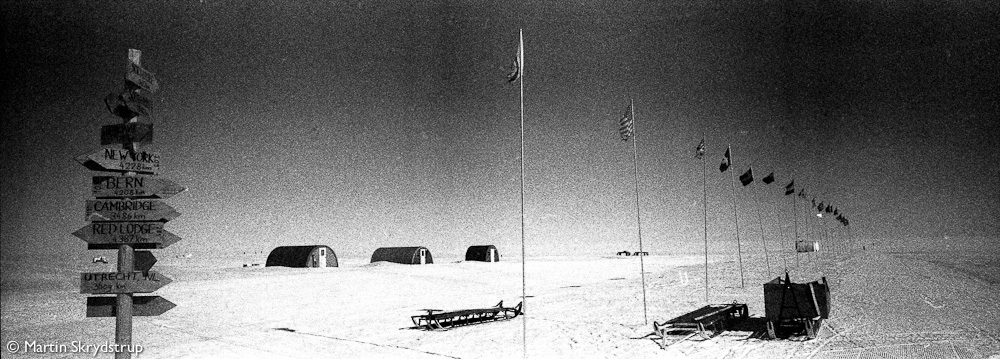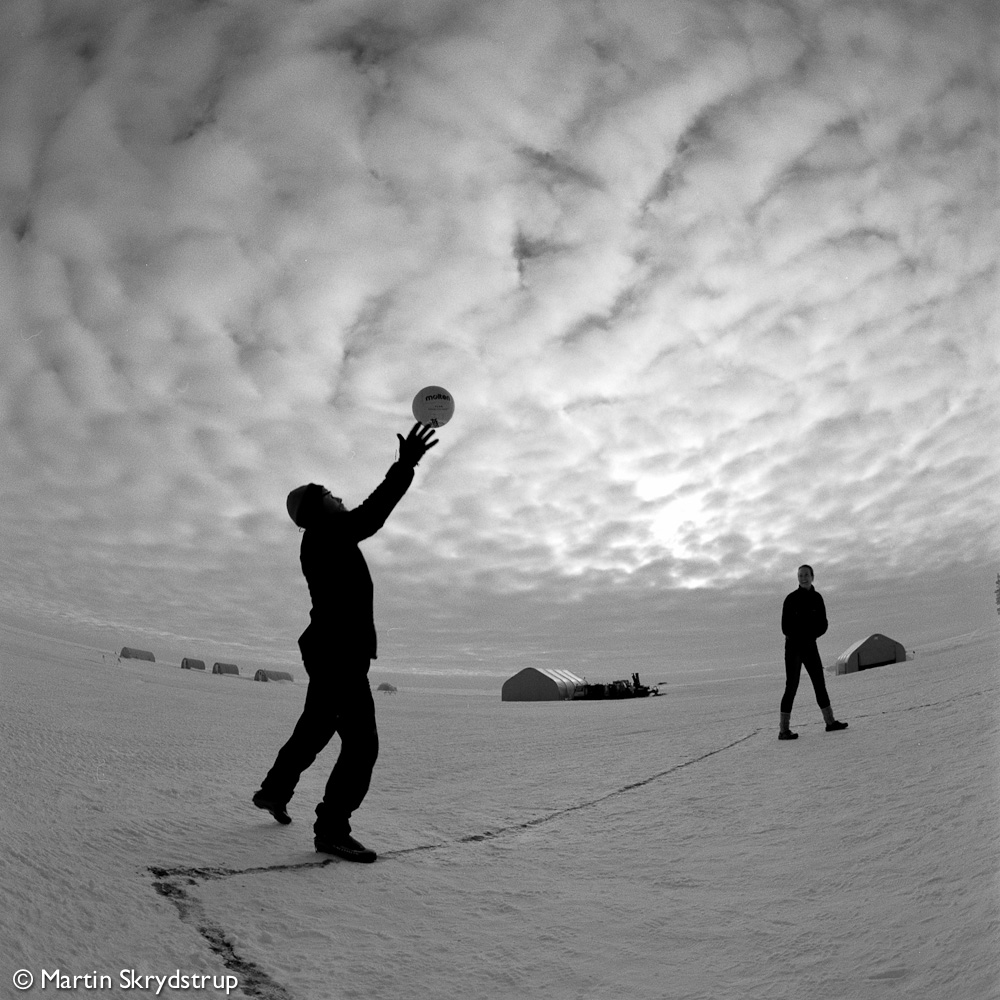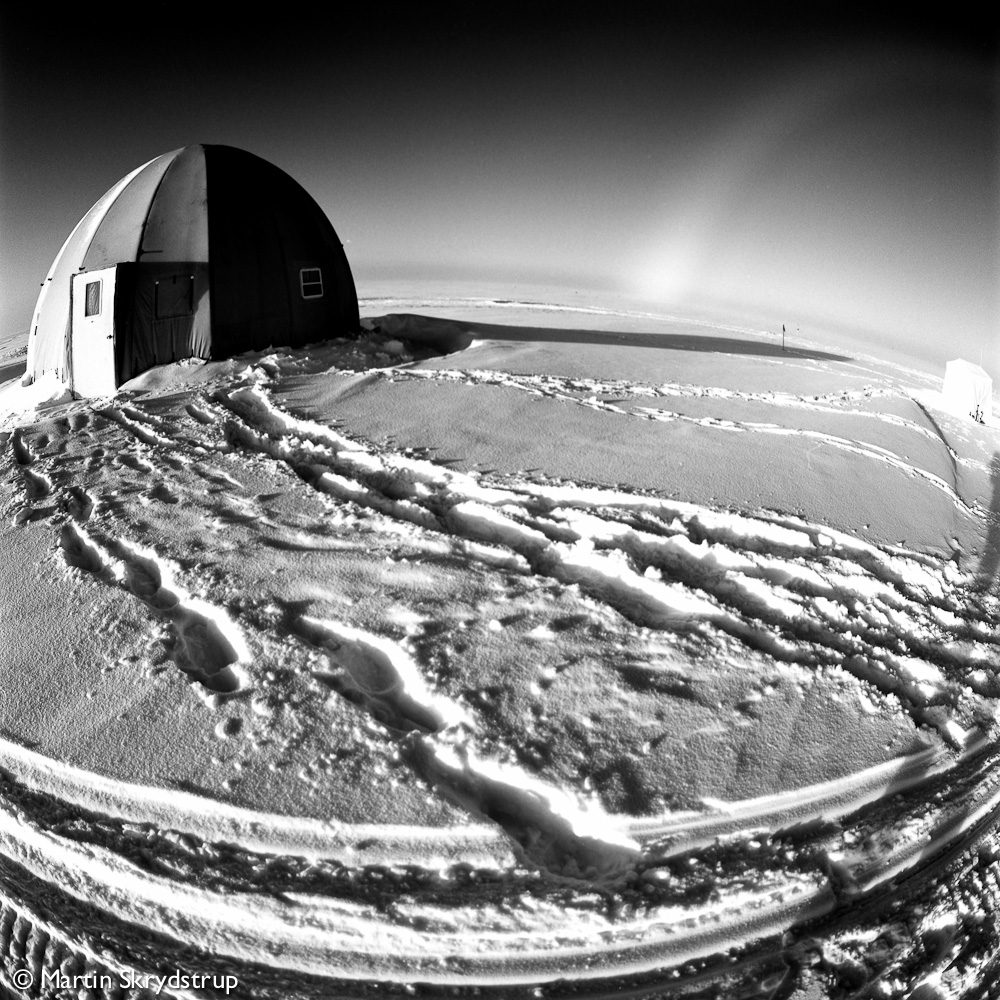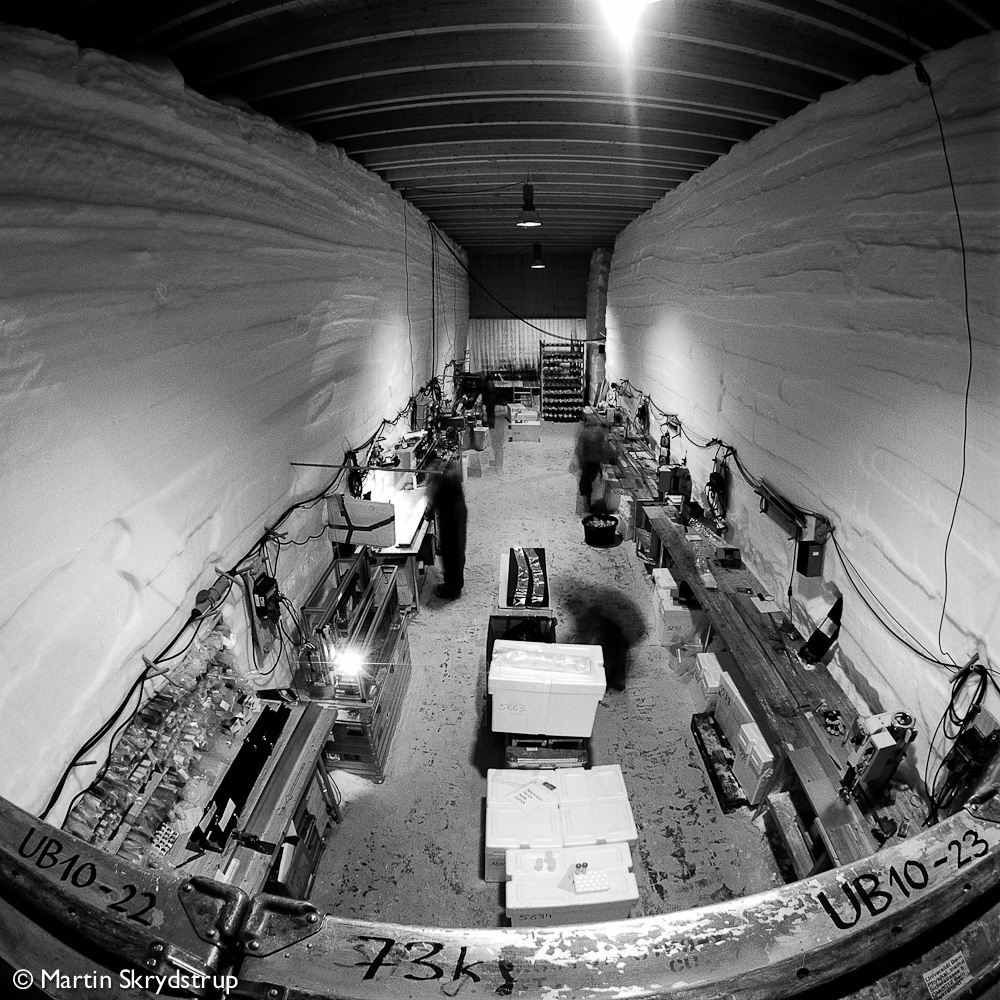A Cold Northern Light
On Capturing and Conveying Cosmo-science with a Camera
By Martin Skrydstrup
Preface
This unique collection of photographs documents a singular "hotspot" of climate research of the outmost significance: The Greenland Ice Sheet. The gallery takes us to the remote and inaccessible research station NEEM (North Greenland EEMian Ice Drilling) located in a pristine environment and portrays the "natives" of the camp, ie ice core researchers from more than twenty different nations. Organized in five thematic clusters, each conceptual prism is drawn from the anthropology of science and constitutes a filter through which I interpret the reality of the NEEM camp. Just like paleo-climatology, the anthropology of science is a science in its own right. It implies a form of writing, which consists of observation and analysis. Conducting fieldwork means - just as in ice core research - to intervene, invent and narrate. Anthropology also subscribes to a somewhat dry but imaginative radical reasoning; a form of reasoning I learned also inhabited most of the minds at NEEM.
These unconventional, at times surprising, at time haunting images offer a compelling yet unsentimental portrait of human fortitude on the ice. The collection affords us a rare insight into the social and material conditions of scientific life. The collection will transport the viewer to an exotic world, within our own, which might hold significant potential for understanding the past climate and thus the future of global warming. Serving as a Cook, Ethnographer and Photographer during the NEEM field season of 2010, I take great pride in being a small part of the NEEM endeavor. However, the question, which nagged me throughout my fieldwork, was if scientific Enlightenment alone could reverse environmentally destructive trends that have been centuries in the making? The short answer to this question is that science in this respect could need a little help form anthropology
The Paradox of Place
When I first spotted the NEEM camp from the cockpit of the Hercules it was in the form of black and red needle heads in the midst of a vast expanse of white. Anticipation with a Malinowskian bent ran high: "Imagine being in a tent on a deserted island with Natives...." I was going to spend the summer in a tent in a far more inaccessible place than the Trobriand Islands. Five weeks of splendid isolation conducting fieldwork in the NEEM community, consisting of a population of only 36 people.
However, after touch down, my romantic inroad to the Greenland Ice Sheet gradually transformed into the world of mundane cooking chores. In the manning plan for NEEM 2010, I had been assigned as an Assistant Cook. When the Cook took me along for a first tour of the camp, he asked me: "How does it feel to be in a place, where less than a handful of people have trotted before you?" Apparently, I was not the only one in camp with a Malinowskian inclination.
In between cooking chores, photography became an interpretative tool to illustrate the conceptual prisms, through which I came to see the camp. I had brought my gear to NEEM, primarily to capture camp life and human fortitude on the ice, as well as the conditions of life in a pristine habitat. As the field leader would often cautiously remind us: "Don't forget that we find ourselves in an extreme environment where none of us would survive very long outside the camp".
The gallery is organized in a number of leitmotivs: CAMP, PORTRAITS, CIRCULATIONS, etc. These themes give visual expression to a number of different visions of the camp, which informed my ethnographic fieldwork. In NEEM, I saw an artificial human habitat, a social pressure cooker, a laboratory in the midst of an ice sheet, etc. However, none of these labels exhaust the place as a paradox: remote and inaccessible, uninhabited for most of the year, but at the same time ever so worldly, featured in world news across the globe as a window to the future of the planet.

The NEEM Main Street: Remote, inaccessible and ever so central to the concerns of our time.
NEEM Time
I remember one American photographer on a short-term assignment to document NEEM, who after dinner went out on Main Street and planted his digital SLR on a tripod, waiting for a beautiful sunset as a backdrop to the camp. When the battery in the camera finally died, he had not got one single shot of the sunset.
At 86 degrees north during summer time, the sun never sets over NEEM. At "night" the sun just moves laterally along the horizon. The camp is therefore embedded in a constant luminosity making snow crystals look like medium carat diamonds, colors seem clearer, truer, sharper, and more saturated than in Copenhagen. However, this type of light is a rare guest at NEEM. Most of the time, the weather is completely overcast, with a dim and diffused light, often with ground fog. This scheme of luminosity gave me a feeling that normal Greenwich time and been suspended in camp. Instead, we were on NEEM time.
In the sub-surface Science and Drilling Trench, about 20 meters below the surface snow; artificial light reigned. For the scientists working here, there was no telling about time, apart from their wrist watches. Some science teams also worked around the clock. However, due to the low temperatures in the Drilling and Science Trench (about minus 18 Celsius), the work schedule here did adhere to a rigid two-hour shift. Throughout the workday, the social life in the main dome revolved around this timetable, which again gave me this sense that we were on NEEM time in the camp. In the series of photographs labeled CAMP, the only telling of the arrow of time is the direction and length of the shadows cast.

Overcast and diffused light around 8pm.

At 3:30am the light is intense; the only telling of time is in the cast of the shadows).
Analogue Naturalism
Shooting B/W analogue film was a radical choice. I choose to work with this technique, because the camp had already been documented extensively in digital SLR. As an anthropologist, I had a different perspective. Aesthetically speaking, I believe the outstanding characteristic of photography is luminosity. In my experience, analogue film is the best instrument to convey the tonal scales of light. On the surface, I shot Ilford Delta 100, with has a fine grain. In the sub-surface drilling and science trench, I either worked with Delta 3200 (giving a grainy and very graphic feel to scientific life below the snow surface), or I worked with a tripod using longer exposure times to convey a sense of shadows moving around an assembly line.
In my tent I kept a table, where I meticulously ordered my cameras and films, according to different kind of schemes and logics. When the scientists in camp visited me, they would often dwell for a little while at the table and then say that I worked just like they did in their labs. There seemed an obvious analogue here between my photographic instruments and theirs.
Today, taking film-based pictures may seem as an anachronism, but I consider it a form of writing with light and fixing shadows. It is a mean of recording nature in a faithful analogue manner, with a strong sense of viewpoint, timing and bricolage with instruments. As such, it is very similar to the kind of analogue naturalism practised by the scientists at NEEM: A faithful translation of Nature, however not without human ingenuity, interpretation and imagination.
 Caption: In the sub-surface science trench, shadows move around an assembly line.
Caption: In the sub-surface science trench, shadows move around an assembly line.
See the full gallery
All Martin Skrydstrup's NEEM pictures are available from the NEEM gallery web page.
Acknowledgements
Without Steen Kelså's digital scan of my celluloid carvings and his skilful digital manipulation and careful corrections of my exposure errors, this NEEM gallery would not look the way it does. I would also like to thank Christian Vium for sharing my interests in visual anthropology and for much inspiration along the way. My gratitude also goes to Dorthe Dahl-Jensen and Jørgen Peder Steffensen for inviting me to join the NEEM field season 2010 and to Sune Olander Rasmussen for his encouragements in making this gallery public. I would also like to acknowledge the generous support from the Centre for Ice and Climate and Waterworlds making this gallery possible.
References
- Descola, Philippe La Fabrique des Images: Visions du Monde et Formes de la Représentation. Quai Branly, Paris: 2010.
- Latour, Bruno Pandora's Hope: Essays on the Reality of Science Studies. Harvard, Mass.:1999.
- Stengers, Isabelle Cosmopolitiques. La Découverte, Paris: 1996.



